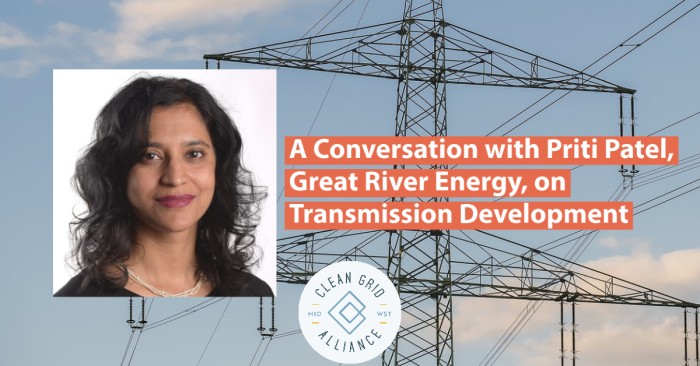A Conversation with Priti Patel, Great River Energy, on Transmission Development
 | Holly Fritz, Communications/Policy Associate |

 | Holly Fritz, Communications/Policy Associate |
With the growing amount of renewable energy additions to the grid, transmission development is crucial. Priti Patel, Vice President and Chief Transmission Officer at Minnesota-based Great River Energy (GRE) gives the low-down on all things transmission: what it’s like to work in an important industry, how industry partners are getting involved and what the public needs to know.
Great River Energy is a member of Grid North Partners (formerly known as CapX2020), a collective of ten utilities working together to “ensure continued safe, reliable and affordable electric service” in the Upper Midwest. These utilities also own and operate transmission infrastructure in their respective footprints.
Why is transmission important, especially as it relates to renewable energy?
“Wind and solar facilities can be built much faster than traditional power plants – the turn-around time for transmission to be built to provide service to a renewable facility needs to be much shorter.
-Priti Patel,
Vice President & Chief Transmission Officer, Great River Energy
As our country continues to move forward with baseload generation retirements and the addition of more and more renewables, transmission becomes the critical link that both brings power from resource onto the grid and ensures reliability. Any power source is only as good as the transmission system that brings it from point A to point B. Much of the discussion around the need for transmission to enable the use of more renewable energy is around the need to build it in a timely manner. Wind and solar facilities can be built much faster than traditional power plants – the turn-around time for transmission to be built to provide service to a renewable facility needs to be much shorter.
What kinds of transmission jobs are there, and what kind of education is needed?
Subscribe to our newsletter for the latest on energy & our work
There is a wide variety of jobs in the transmission industry and the area of need will continue to grow. Most are engineering, technician and system operations positions. Traditional engineers work in the office, while many of the technicians, such as line technicians, work in the field. Outside those areas are jobs in the land rights, environmental permitting, compliance and business development and strategy areas. Depending on the role, most jobs in transmission require either 4-year college degrees or 2-year technical degrees.
What are the major challenges and rewards in working on transmission?
Transmission is a complex industry, which can mean you face a significant learning curve when you first enter the industry. That said, you will never be bored! The industry continues to change and evolve as technology, policy and customer expectations grow. And at the end of the day, transmission is delivering an essential service.
“Transmission is delivering an essential service.
- Priti Patel,
Vice President & Chief Transmission Officer, Great River Energy
It feels good to know that we are working in an industry that powers peoples’ lives, keeps them safe and enhances their quality of life.
What does the public need to know about transmission?
“The public needs to know that transmission plays a critical role in ensuring they have the power they need and that having the right transmission in place is what ensures it will be reliable and affordable.
- Priti Patel,
Vice President & Chief Transmission Officer, Great River Energy
The public needs to know that transmission plays a critical role in ensuring they have the power they need and that having the right transmission in place is what ensures it will be reliable and affordable. As
our generation resource mix continues to evolve to allow for more wind, solar,
storage and distributed generation, the need for transmission will grow. They
also should know that building transmission is a team sport - utilities work
together with policymakers, environmental groups and other
stakeholders to
ensure the right transmission is built at the right time.
How does Great River Energy and the other Grid North utilities inform communities about new transmission projects and get their input?
Our public outreach process includes education right now to help the public better understand what is occurring in the energy industry and how it may impact them. We talk to local government officials, property owners and others who may be directly impacted by our projects to inform them about the project and gather input. Depending on the scope of the project, we often also hold public open houses to provide the community as a whole a way to learn about the project and ask any questions they may have. We also reach out to local reporters so they can write stories for their newspapers.
What has GRE (and Grid North utilities) learned about working with communities on transmission over the past decade?
We have learned that the more informed and educated people are about a project, the more likely it is that they will embrace the new infrastructure in their communities. Holding an open house to explain the need for a project and the rationale behind our proposal goes a long way. People want a chance to ask their questions and provide their feedback, and we know sometimes local feedback from the people who actually live and work in those communities is invaluable.
How quickly will communities see new transmission projects that MN utilities need for transitioning generation fleets?
Utilities build transmission every year to maintain reliability, enable the transition of generation fleet, and support local load growth. That trend will continue. As larger, more regional transmission projects get approved by the Midcontinent Independent System Operator (MISO), communities may see projects that cross state boundaries and are higher profile. We expect some regional projects to get approved in the next few years, after which the responsible utilities would begin moving forward with development plans around the transmission projects.
Clean Grid Alliance (CGA) has spent the last 20 years as the “power behind the power” working with legislators, regulators, NGO colleague organizations, and many other stakeholders to deliver this clean energy future across the Midwest. Significantly, CGA has been working with MISO since its inception in 2001 on transmission expansion to accommodate new renewable generation, facilitate an economic energy marketplace, and ensure reliability. Finding common goals among different interests and keeping the public interest in mind has helped move the region toward carbon-free energy. Curating these partnerships with utilities like GRE are a priority for Clean Grid Alliance in our mission to deliver a clean energy future to the Midwest.